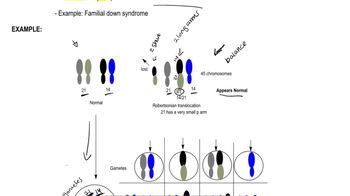A healthy couple with a history of three previous spontaneous abortions has just had a child with cri-du-chat syndrome, a disorder caused by a terminal deletion of chromosome 5. Their physician orders karyotype analysis of both parents and of the child. The karyotype results for chromosomes 5 and 12 are shown here. What is the approximate probability that the next child of this couple will have cri-du-chat syndrome?
Table of contents
- 1. Introduction to Genetics51m
- 2. Mendel's Laws of Inheritance3h 37m
- 3. Extensions to Mendelian Inheritance2h 41m
- 4. Genetic Mapping and Linkage2h 28m
- 5. Genetics of Bacteria and Viruses1h 21m
- 6. Chromosomal Variation1h 48m
- 7. DNA and Chromosome Structure56m
- 8. DNA Replication1h 10m
- 9. Mitosis and Meiosis1h 34m
- 10. Transcription1h 0m
- 11. Translation58m
- 12. Gene Regulation in Prokaryotes1h 19m
- 13. Gene Regulation in Eukaryotes44m
- 14. Genetic Control of Development44m
- 15. Genomes and Genomics1h 50m
- 16. Transposable Elements47m
- 17. Mutation, Repair, and Recombination1h 6m
- 18. Molecular Genetic Tools19m
- 19. Cancer Genetics29m
- 20. Quantitative Genetics1h 26m
- 21. Population Genetics50m
- 22. Evolutionary Genetics29m
6. Chromosomal Variation
Chromosomal Rearrangements: Deletions
Problem 32b
Textbook Question
A healthy couple with a history of three previous spontaneous abortions has just had a child with cri-du-chat syndrome, a disorder caused by a terminal deletion of chromosome 5. Their physician orders karyotype analysis of both parents and of the child. The karyotype results for chromosomes 5 and 12 are shown here. Which parent has an abnormal karyotype? How can you tell? What is the nature of the abnormality?
 Verified step by step guidance
Verified step by step guidance1
Step 1: Understand the genetic basis of cri-du-chat syndrome. This syndrome is caused by a terminal deletion on the short arm of chromosome 5 (5p). The deletion results in the loss of genetic material, leading to the characteristic symptoms of the disorder.
Step 2: Analyze the karyotype results of the child. Look for evidence of the terminal deletion on chromosome 5. Specifically, compare the size and banding pattern of chromosome 5 in the child’s karyotype to a normal chromosome 5.
Step 3: Examine the karyotype results of both parents. Check for any structural abnormalities in their chromosomes, particularly chromosome 5 and chromosome 12, as these are mentioned in the problem. Look for signs of a balanced translocation or other structural rearrangements.
Step 4: Determine which parent has the abnormal karyotype. If one parent has a balanced translocation involving chromosome 5, this could explain the child’s terminal deletion. A balanced translocation means that no genetic material is lost or gained in the parent, but it can lead to unbalanced gametes during reproduction.
Step 5: Conclude the nature of the abnormality. If a parent has a balanced translocation involving chromosome 5, the child likely inherited an unbalanced form of this translocation, resulting in the terminal deletion on chromosome 5. This explains the child’s cri-du-chat syndrome and the history of spontaneous abortions, as unbalanced translocations often lead to nonviable pregnancies.
 Verified video answer for a similar problem:
Verified video answer for a similar problem:This video solution was recommended by our tutors as helpful for the problem above
Video duration:
1mPlay a video:
Was this helpful?
Key Concepts
Here are the essential concepts you must grasp in order to answer the question correctly.
Karyotype Analysis
Karyotype analysis is a laboratory technique that involves the examination of an individual's chromosomes to identify structural abnormalities, such as deletions, duplications, or translocations. It provides a visual representation of the chromosome number and structure, allowing for the detection of genetic disorders. In this case, analyzing the karyotypes of the parents and child will help determine if there are any chromosomal abnormalities contributing to the child's cri-du-chat syndrome.
Recommended video:
Guided course

Chi Square Analysis
Cri-du-chat Syndrome
Cri-du-chat syndrome is a genetic disorder caused by a deletion of a portion of chromosome 5, specifically at the 5p15.2 region. This condition is characterized by distinctive features, including a high-pitched cry resembling that of a cat, developmental delays, and various physical anomalies. Understanding this syndrome is crucial for interpreting the karyotype results and assessing the genetic implications for the parents and child.
Recommended video:
Guided course

Robertsonian Translocations
Chromosomal Abnormalities
Chromosomal abnormalities refer to changes in the normal structure or number of chromosomes, which can lead to genetic disorders. These abnormalities can be numerical, such as aneuploidy (extra or missing chromosomes), or structural, such as deletions, duplications, or inversions. Identifying the nature of the abnormality in the karyotype results will help determine which parent may carry a genetic risk factor that could have contributed to the child's condition.
Recommended video:
Guided course

Chromosome Structure
Related Videos
Related Practice
Textbook Question
308
views


